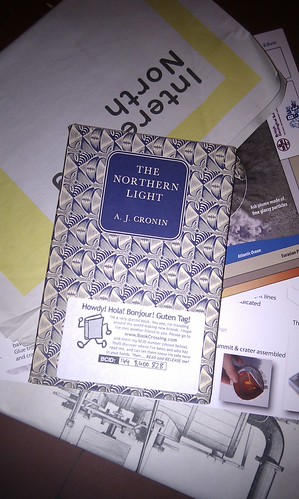I love going to conferences, and I love writing about them, but I hate doing those write-ups that march relentlessly through the speakers in the order they appeared. If you wanted that kind of experience of Interesting North my best recommendation was to go to the conference yourself. Or click the links on Lanyrd.com, which is rapidly becoming the de facto, vowelly-challenged implementation of Adrian McEwen’s Long Conference.
Instead I get to indulge my all-too-human cognitive bias towards the Clustering Illusion by trying to weave a single coherent pattern out the joyously random talks that Tim Duckett and the crew lined up for us in Sheffield last weekend. The pattern I see is made of Baseball, Poker, music, sleeping and Lego.
Stefanie Posavec talked delightfully on Baseball Scorekeeping. True to the Interesting brief to share a secret passion, she applied the graphic designer’s eye to the folk infographics of amateur scorekeeping. I loved the idea that these scraps of paper depicted, in just a few dozen square inches, the entire arc of a three-hour sports event, reducing the excitement of a live event to just a few pencil marks, yet preserving so much information in the process.
This too seemed to be the process in electronic music, laid bare by Ed Goring‘s live demo of the amazing tools that shape the music we hear around us. Ed illustrated graphically how barriers to creativity have tumbled as software in bedrooms replaced multi-million pound studios.
But the thing that jumped out at me was how basic some of those music user interfaces looked – as unlike the music they made as Stephanie’s baseball scorecards were unlike the games they recorded. Just as some of the first cars sported wooden horses to help travellers feel at ease in the new horseless carriages, so Ed’s laptop was filled with software interfaces made to look like the studio mixing desks and hardware widgets of yore.
I got the feeling that there must be more to it than this. What happens when you put a Wii controller in the musician’s hand, or the musician in the path of a Kinect sensor? Or, for that matter, give them the kind of mind-boggling multi-screen UI that the world’s elite online Poker players use to play multiple tables at a time, using software to spot interesting activity that merits their costly attention?
Chris Dymond‘s talk on poker was an eye-opener, exposing the way the web is not just multiplying the amount of Poker played but fundamentally changing the game itself, thanks to increased visibility and the use of sophisticated number-crunching over massive databases of past hands. I also wrote down in my notebook “elite Swedish Poker psychologists.” Over lunch, I was lucky enough to hear Chris expand a little on the culture clash between the old and new worlds of Poker, and how the new online players may get through more hands in a month than an old-time champion did in his whole career. The rules may be the same but they’re playing a different game.
Which brings us to Five Things Rules Do, Tom Armitage‘s lovely discussion of games – all kinds of games. I’m a sucker for user-generated innovations like rocket jumping, especially when designers manage to embrace and extend the rule-bending as part of the game. The most profound parts of Tom’s talk were the simple and heartfelt accounts of how rules embody stories – from the doubling dice that says “Backgammon is a social game for drunk people” to the softly-spoken messages of Gravitation and Waldschattenspiel, or the more brutal Train.
Oli Shaw‘s Catching Sleepers pulled off just this kind of magic. Whoever gave him the mid-afternoon slot was a genius. It certainly made me feel sleepy. I’m still not sure quite how Oli got away with showing photos of numerous unsuspecting individuals caught asleep on public transport without being drummed out of the Cutlers’ Hall by a crowd baying “stalker!”. I think it was because of the tenderness with which he spoke of his victims. As did Frankie Roberto showing us his Lego collection (“sorted by size, not colour, which would just be wierd”) and exposing the foibles of his fellow AFOLs. Lego seemed to embody its own sophisticated rulesets and creative constraints.
And more, much more, such as James Boardwell on the bikes of the future and Toby Barnes on James Bond: Architecture Critic, both of which I think I’ll come back to in future posts. Oh, and Sheffield honey, riding sidesaddle, cake, a tourist volcano, wikiality and some other stuff.
I got to impose on the crowd for 10 minutes with my story of Green Sand and Subterfuge, also stuffed into the goody bags in glorious newsprint. A pedant might say this story of 1802 Leeds was a little out of place in Sheffield’s 30-years-younger Cutlers’ Hall, but there was a John Ruskin quote on the wall, and the audience made me feel very welcome.
Also, my own goody bag contained this book, which seemed fitting.
Thanks once again to Tim and everyone else who made Interesting North happen. I really hope it becomes an annual fixture.



Interesting (if you’ll pardon the pun) idea about lanyrd and #longconf. I’m not sure it is quite what I’m driving at with that, but it definitely deserves some more thought. Thanks.
You’ll be pleased to hear that musicians are already experimenting with things like the wiimote – The Amazing Rolo has built some (open source, IIRC) software that lets you scratch and sequence new music with a wiimote and nunchuck.
And the Monome provides arrays of programmable, LED-lit buttons which, in the right hands, can produce amazing results. I was blown away by Stretta switching in and out tracks live on one half of his 256-button Monome whilst simultaneously sequencing the next section on the other half.
Videos and more links to both artists are at the end of my review of Interface Amnesty last year.
Thanks, I’m looking forward to checking out that music when I’m in a quiet place :) I guess my thought on Lanyrd is not to say that it’s the same as longconf, but that it certainly seems to encourage spontaneous conference-elongating behaviours in a way that other event services have not. Really interested to see where your ideas on conferences lead to. Matt